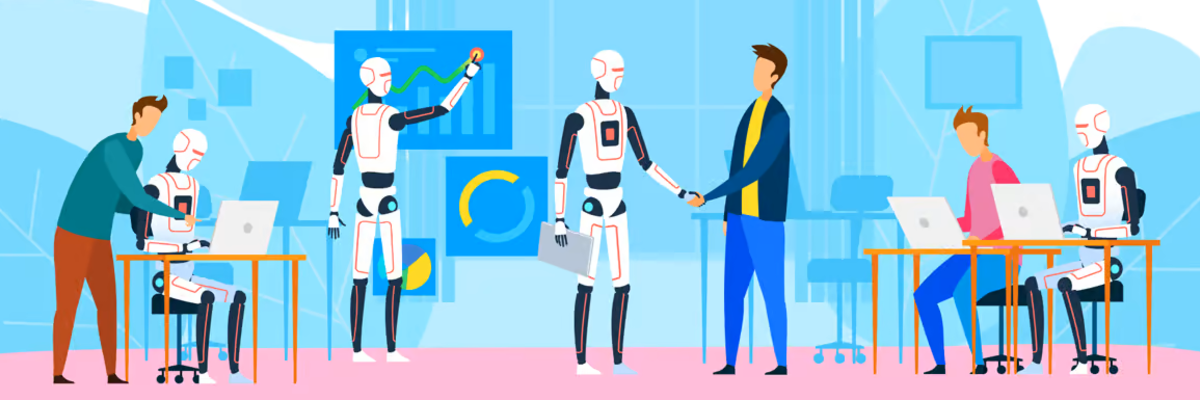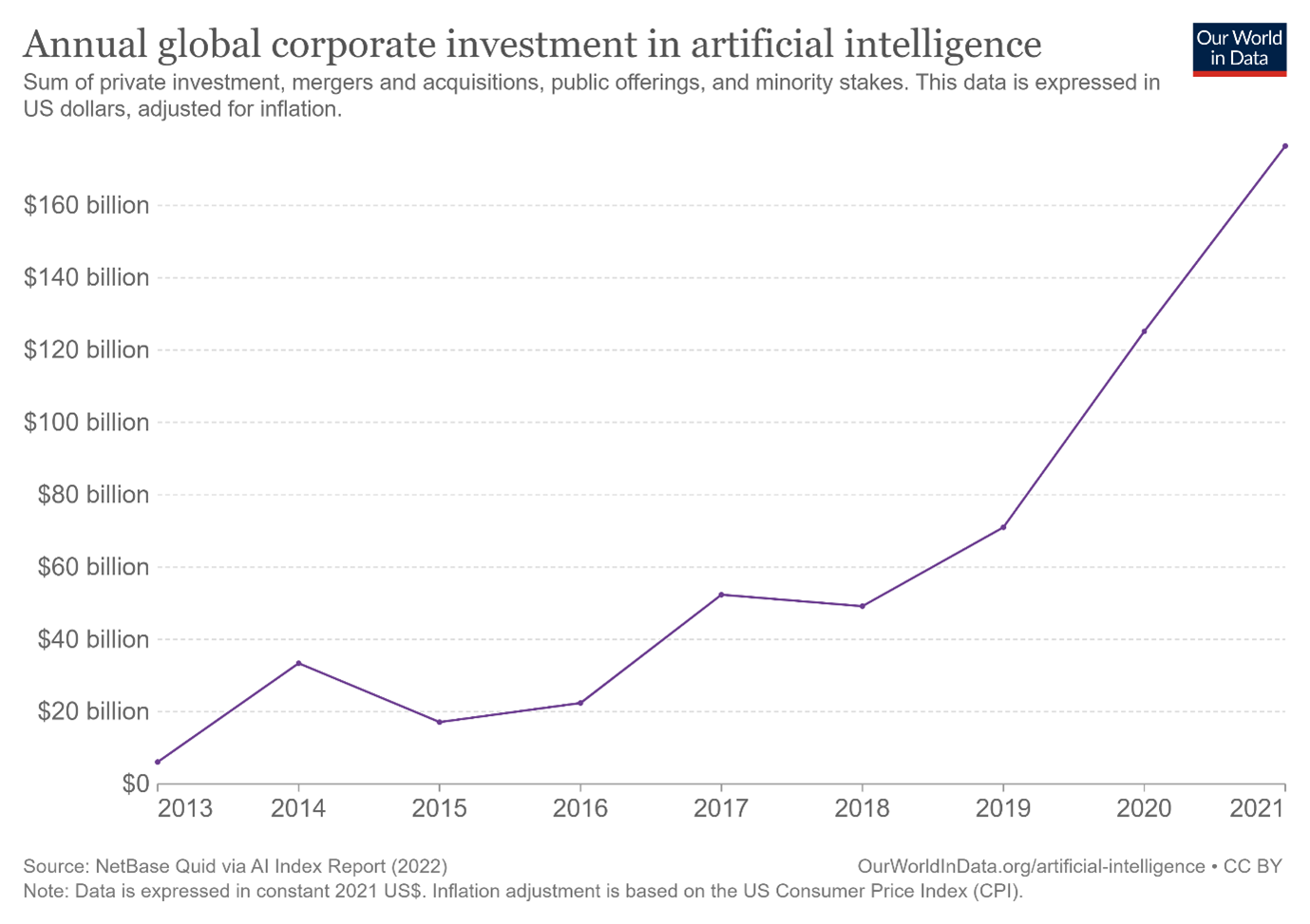AI: The Future is Now - Are You Ready to Embrace it?
25 January 2023

With the publication of ChatGPT-3 a new barrier was breached in the field of Artificial Intelligence (AI). For the first time a large language model was easily available to the public. This resulted in widespread coverage in mainstream media, use-cases being explored by non-technical personnel and both the celebration and the outcry of the effects that AI can and could have on our society as a whole. This blogpost will look into the evolution that AI has made in order to become what it is today. Next to that we will look forward, how AI can likely impact our future. Lastly, we will try to formulate a plan of attack that companies need to consider to be best prepared for the drastic changes that AI will have on our way of working.
The early start of artificial intelligence
The first AI system dates back to 1950. At this point AI consisted of a robotic mouse that could learn to navigate a maze. Fast forward a couple of years and you have AI systems on par with human capability for cognitive tasks. In 1996 Deep blue beat the world chess champion Gary Kasparov. But a few years before you also had the program; ‘TD-Gammon’ which was an AI based system that was just slightly worse at backgammon than top human players at that time. Both these examples are AI models learning to perform very specific tasks. More recently AI systems have focused on more general functions like image recognition, speech recognition and reading comprehension. Ten years ago no machine was able to provide consistent reliable output on these tasks. However today, all these tasks can be performed by computers at a level that surpasses human capabilities. Just think that through for a bit. We have computer systems that are able to interpret pictures and text more accurately than humans!

Rapid developments despite limited resources
When you hear the developments of AI, you would expect that the resources for this field, to do research and create experiments, are abundant. This however has not been true in the past. Academic interest in the domain did not gain traction quickly. Some people even describe ‘AI winters’, where interest and funding for artificial intelligence took a significant downturn. The theory for deep learning stems back from 1962 but wasn't successful at this time due to lack of training data and limited computing power. A big tipping point for the improved performance, and as a result the interest of the industry, was the victory of AlexNet in the ImageNet Large Scale Visual Recognition Challenge on September 30, 2012. This model was successfully trained on GPU’s which made it possible to develop a more complex architecture. The development of better hardware and bigger models has continued throughout the years, resulting in more accurate models. Due to this process AI has been able to confirm its value in society, which has lead to increasing amount of resources being spend on supporting the further growth of AI. As such, private investment, scholarly publication and job postings all have increased in the last five years. This will further support the development of artificial intelligence and the speed with which the field develops.

The impact of AI today
Although AI will evolve even more in the future, we should not be blind to the effects that AI already has on our day to day lives. AI is being used across a wide range of industries, from healthcare and finance to transportation and retail. One of the most visible impacts of AI is in the form of virtual assistants, such as Amazon's Alexa and Apple's Siri, which are becoming increasingly common in homes and workplaces. In healthcare, AI is being used for tasks such as medical diagnosis, treatment planning, and drug discovery. In finance, AI is being used to detect fraud and make stock market predictions. In transportation, self-driving cars are starting to hit the roads and are expected to significantly reduce accidents and increase efficiency.
When will AI replace the human?
Discussions about the evolution and future capabilities of AI are inherently very uncertain. No wide range agreement exists on what exactly is ‘general AI’ or if we should compare the capabilities of AI against those of humans.
However a group of forecasters predicts that a ‘weak general AI’ will be publicly known within five years. This is a single AI system that is indistinguishable from humans in written text, understands the meaning of text, is able to perform college level mathematics and can play video games. The prediction made by the forecasters is somewhat an ‘optimistic’ prediction in the sense that it is early compared to other predictions being made. However, if you ask experts about ‘transformative AI’ or ‘human-level AI’ most of them agree that this would be developed within the lifespan of teenagers today. The development of an AI system with similar capabilities as humans would fundamentally impact the way in which business ‘as usual’ will be conducted and has the possibility to drastically change the way in which society is structured.
How can businesses prepare to adopt AI?
The impact of AI is already present in our day to day lives. The presence of AI is likely to only increase in the future. For businesses the question around AI has long surpassed the stage of ‘Should we adopt AI?’ and the main question is now ‘How can we successfully generate business value from AI technology?'. First businesses should define a strategy around AI. This includes identifying possible use-cases, quantifying their value by clearly define the business problem or opportunity that the organization is looking to address and finally setting up a plan to execute these projects.
To be able to properly execute these projects companies should also consider the broader context of these projects. First of all, data is still the central driver to AI. Making sure that the data is well managed and governed is therefore key. In addition, AI systems need a high amount of computational power. Companies need to consider how to invest and manage high-powered computing systems. This includes the choices around cloud infrastructures and services, open source software and hardware options. Next to that the company also needs skilled personnel to develop, manage and maintain AI solutions. A strategy needs to be developed to find, develop and keep the needed persons and skills within the company. Lastly legal and ethical considerations need to be mapped and weighted. Because maybe not all profitable AI projects should be pursued.
Conclusion
We have looked at the history and development of Artificial intelligence. Although the impact of this technology is already wide-spread in today’s society, it is likely that it’s future influence will be underestimated by a lot of organizations. Businesses need to recognize the potential that AI has as an emerging technology and react by creating a strategy that outlines the meaningful projects that should be pursued. Companies that fail to develop this strategy and that cannot act on it will risk falling behind and potentially be out-run by the competition.
Want to have a word on how your organization can prepare for AI and how you can generate business value from AI technology? Contact us, we are always happy to talk!
